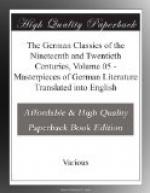This unlimited universality of Painting is demonstrated by History itself, and by the examples of the greatest masters, who, without injury to the essential character of their art, have developed to perfection each particular stage by itself, so that we can find also in the history of Art the same sequence that may be pointed out in its nature—not indeed in exact order of time, but yet substantially. For thus is represented in Michelangelo the oldest and mightiest epoch of liberated Art, that in which it displays its yet uncontrolled strength in gigantic progeny; as in the fables of the symbolic Fore-world, the Earth, after the embrace of Uranus, brought forth at first Titans and heaven-storming giants before the mild reign of the serene gods began.
Thus the painting of the Last Judgment, with which, as the sum of his art, that giant spirit filled the Sistine Chapel, seems to remind us more of the first ages of the Earth and its products, than of its last. Attracted toward the most hidden abysses of organic, particularly of the human form, he shuns not the Terrible; nay, he seeks it purposely, and startles it from its repose in the dark workshops of Nature. Want of delicacy, grace, pleasingness, he balances by the extremest energy; and if he excites horror by his representations, it is the terror that, according to fable, the ancient god Pan spreads around him when he suddenly appears in the assemblies of men.
It is the method of Nature to produce the extraordinary by isolation and the exclusion of opposed qualities. Thus, it was necessary that, in Michelangelo, earnestness and the deep significant energy of Nature should prevail, rather than a sense of the grace and sensibility that belong to the Soul, in order to display the extreme of pure plastic force in the painting of modern times.
After the earlier violence and the vehement impulse of birth is assuaged, the spirit of Nature is transfigured into Soul, and Grace is born. This point Art reached, after Leonardo da Vinci, in Correggio, in whose works the sensuous Soul is the active principle of Beauty.
* * * * *
As the modern fable of Psyche closes the circle of the old mythology; so Painting, by giving a preponderance to the Soul, attained a new, though not a higher step of Art.
This Guido Reni strove after, and became the proper painter of the Soul. Such seems to us to be the necessary interpretation of his whole endeavor, often uncertain, and, in many of his works, losing itself in the vague.
This is shown, as, perhaps, in few of his other pictures, in the masterpiece that is offered to the admiration of all in the great collection of our king.
In the figure of the heavenward-ascending Virgin, all harshness and sternness are effaced, even to the last trace; and, indeed, does not Painting itself seem in it to soar upward, transfigured on its own pinions, as the liberated Psyche delivered from the severity of Form?




